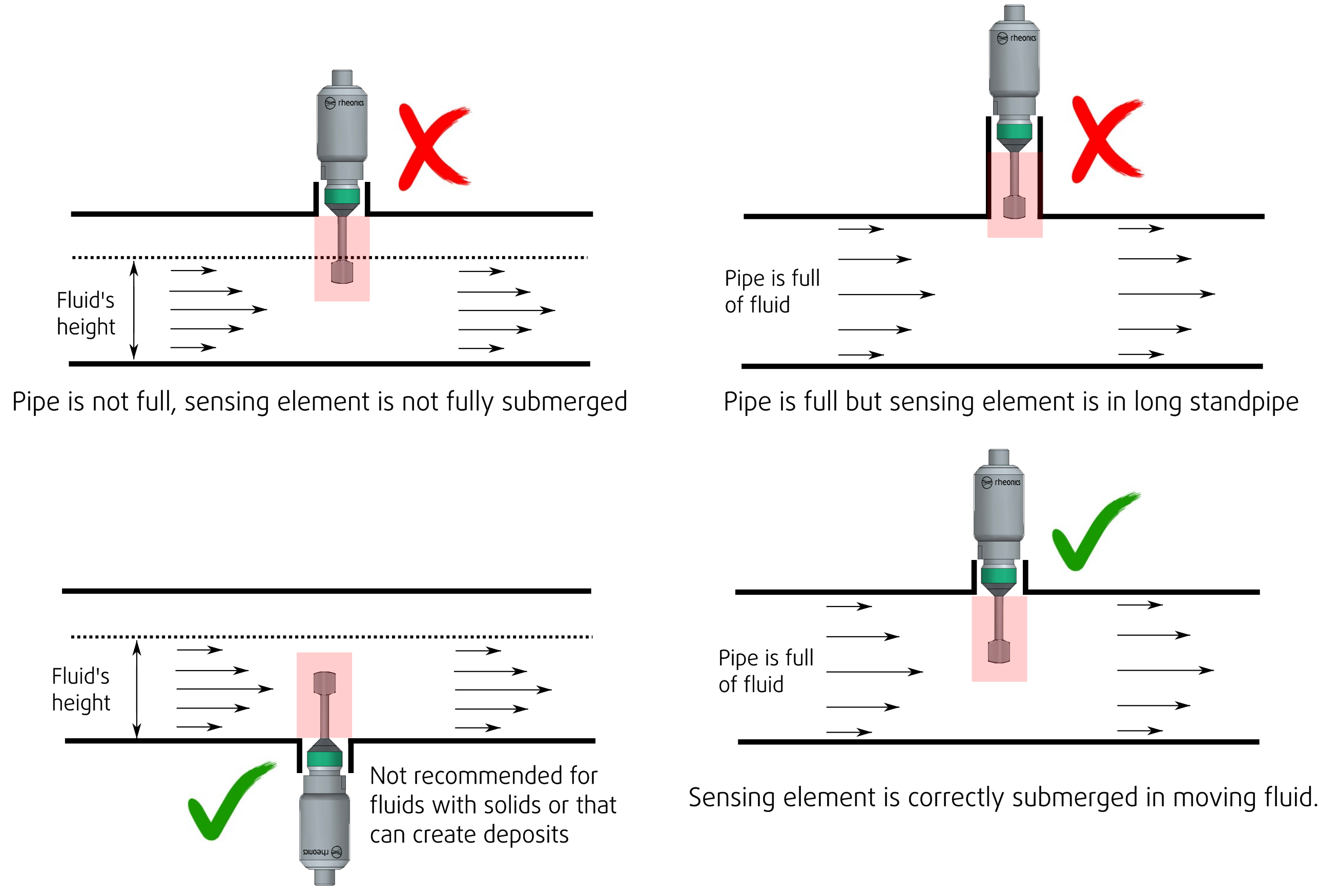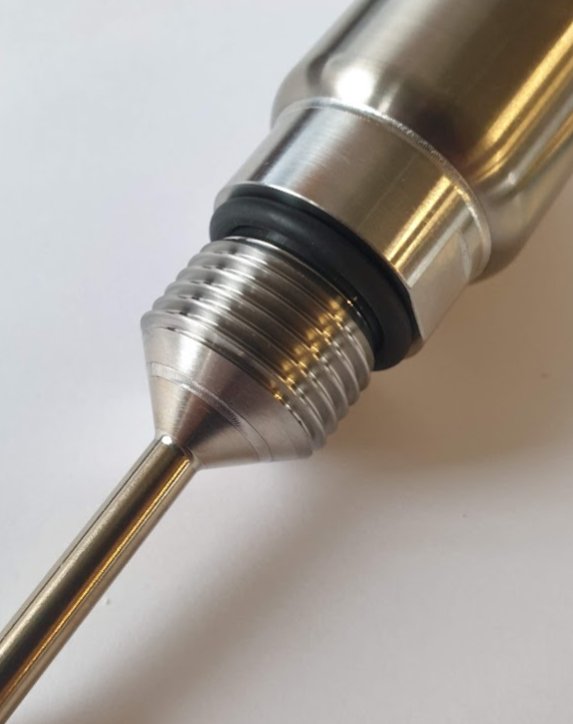What products are involved?
SRD Inline density and viscosity meter.
What is the purpose of this article?
To provide guidance on the installation of the G1/2” SRD sensor (SRD-X1-12G).
1. IntroductionSRD is Rheonics sensor for inline density and viscosity measurements. This sensor is suited for pure density application, as well as when a simultaneous measurement of dynamic or kinematic viscosity is needed. Read more on the SRD here.
The Industrial G connection is a cylindrical thread connection that follows the norm ISO 228. It is also referred to as BSPP (British Standard Pipe Parallel). It requires an O-ring for correct sealing. A Ø17.86x2.62mm O-ring is used for standard installation of the sensor.
The SRD with the G1/2” thread connection has the order code SRD-X1-12G.
G 1/2” connection is only recommended for SRD in applications where measurement is done at temperatures between 25-45 °C (75 °F - 115 °F).
 Figure 1: SRD G1/2” dimensions
Figure 1: SRD G1/2” dimensions
Specifications | |
Sensor | |
Order code | SRD-X1-12G |
Connection type | G 1/2" |
Drawing and CAD file | |
2. General installation guidelinesSR-sensors can be placed at any point in a process and at any orientation but the following considerations should be observed to ensure stable, accurate, low-noise measurements
2.1 Submersion
The SRD sensor has a sensing element shown inside the red section in Figure 2. This section of the sensor should always be fully submerged in the fluid since the SRD measures what is in contact with its sensing element. Incomplete submersion is a potential problem when the flow rate is low and the pipe isn’t full. A possible solution for low flow rates is placing the sensor horizontally and parallel to the fluid (e.g. in an elbow) instead of a vertical and perpendicular installation.
Notice that a clearance is needed below the sensor’s tip from any external obstruction (e.g. pipe inner wall).
Concentration of bubbles within this area can affect the readings, most common consequences of bubbles are a decrease in density and an increase in viscosity.

Figure 2: SRD-G1/2” sensing area
2.2 Stagnation/dead zone
It is not good practice to have dead or stagnant zones around the sensing area (Figure 2). These are defined as any space, inside the red zone, where fluid transport is insufficient leading to immobile fluid, as well as possible accumulation of solids and deposits, or unwanted material like air. These all have negative effects on the measurement.
The SRD is significantly affected by stagnation zones, leading to incorrect measurements due to part or all of the measurement being influenced by stationary fluid that is no longer representative of the actual process fluid. This is a common issue for viscosity on the SRD, and examples are long standpipes or weldolets that create considerable gaps around the sensor.
2.3 Recommended orientation
SRD has a sensing tip that is recommended to be aligned with the fluid flow direction to avoid creating recirculation zones around it. Read more on this topic, here.
 Figure 3: SRD tip orientation.
Figure 3: SRD tip orientation.
2.4 Flow
The flow rate for newtonian and non-Newtonian fluids shouldn’t significantly affect the density readings of the SRD. However, fluctuations in density may still occur throughout a process that can be associated with changes in the state of the fluid (static and moving conditions) and will most likely occur if aggregates are added to the fluid in a mixing process. SRD is perfectly suited to monitor these changes in density.
The scenario for viscosity is different. For Newtonian fluids flow rate does not affect the viscosity, so SRD should measure the same values in static and moving states of a fluid. But for non-Newtonian fluids, the flow rate does matter and viscosity readings may differ between static and moving conditions. The recommendation for processes with non-constant flow rates is to install the SRD in a section in the pipeline with the most consistent flow rate to have a steady viscosity value.
Flow rate is also relevant to ensure the full submersion of the SRD sensing element into the fluid, which is needed for the correct operation of the sensor. For a process with a low flow rate, pipes may not be full at all points, so the SRD should then be placed in a section where the pipe is usually full of fluid (i.e. after a pump).
In all cases, the SRD’s sensing element should be completely submerged in the fluid. It’s best to avoid installations with long standpipes, since that may lead to a bad fluid transfer resulting in measurements that do not reflect the true state of fluid or worse high noise measurements.

Figure 4: SRD-X1-12G installation indications
2.5 Common applications for SRD
The SRD is used with all next common, but not limited to, the next fluid types. Some examples are: and behaviors.
- Static and moving Newtonian fluids
- Static and moving non-Newtonian fluids: Density readings should be constant for all states of the same fluid. Viscosity readings may differ between states.
- Investment casting slurries: This is a typical use case for the SRD. Density in slurries varies with time, as slurry ages and as it is mixed. Installation in slurry rotating tanks is common, changes in the spinning velocity and the insertion of molds to the tank will be noticeable with the SRD readings. Rheonics has developed an Integrated System called SlurryTrack for this and other slurry applications (e.g. Drilling mud slurries, battery electrode slurry, CMP slurry).
- Fluids with solids of micrometers scale: Solids of this size shouldn’t affect measurements.
- Fluids with large-size solid particles: Solids with large size (>3mm diameter) will most likely create spikes in the SRD readings when these hit the sensor. Depending on the percentage of solids in the fluid and after some data analysis, onboard filters can be applied to reduce the noisiness of measured data. However, it is helpful to avoid this kind of solids or install the sensor axially to reduce the cross-sectional area of the sensing element exposed to particle impingement.
Some fluids create deposits around the sensor over time. Noisy readings and an increasing slope in the plotted data can be indicators of deposits around the sensor (i.e. the sensor is dirty). In these cases, proper cleaning should be performed. The frequency for cleaning the sensor depends on the application and may be is different for each application or installation.
3. Installation options3.1. G1/2" Weldolets - HAW accessories
The HAW line of Rheonics weldolets enable the installation of the SRV-12G in tanks and pipes (also suitable for the SRD). These weldolets have two versions, one with metal-metal sealing and another with an O-Ring Ø15.1×1.6 mm sealing for hygienic installations. Hygienic certification for the latter adapter is currently available with 3-A, but EHEDG certification is planned.
- HAW-12G-MTK: Weldolet with metal-metal seal
- HAW-12G-OTK2: Weldolet with a Ø15.1×1.6 mm O-ring seal

Figure 5: HAW-12G-MTK

Figure 6: HAW-12G-OTK2
3.2. Threaded port on pipe or tank wall
Sensor probe installation is also possible by creating a threaded hole in the pipe or tank. Installation requires a Ø17.86x2.62 mm O-ring.
In tank installations, it is recommended to place the sensor at a level that has always fluid. The entire sensing element must be submerged in the fluid so it can also be placed at a tank’s bottom.

Figure 7: SRD G1/2” with O-ring mounted in a wall
Steps for installation in walls:
A hole with G1/2” threads is needed in the wall.
i. Place the Ø17.86x2.62 mm O-ring seal on the sensor, so it fits the notch of the sensor just above the thread.
 Figure 8: SRV G 1/2 with O-ring
Figure 8: SRV G 1/2 with O-ring
ii. Insert the sensor into the female thread part. Manually, give it enough turns until noticing the correct sealing with the wall or adapter adaptor pressing against the O-ring.

Figure 9: SRD G1/2” in wall drawing
References[1]: https://rheonics.com/products/inline-density-meter-srd/
